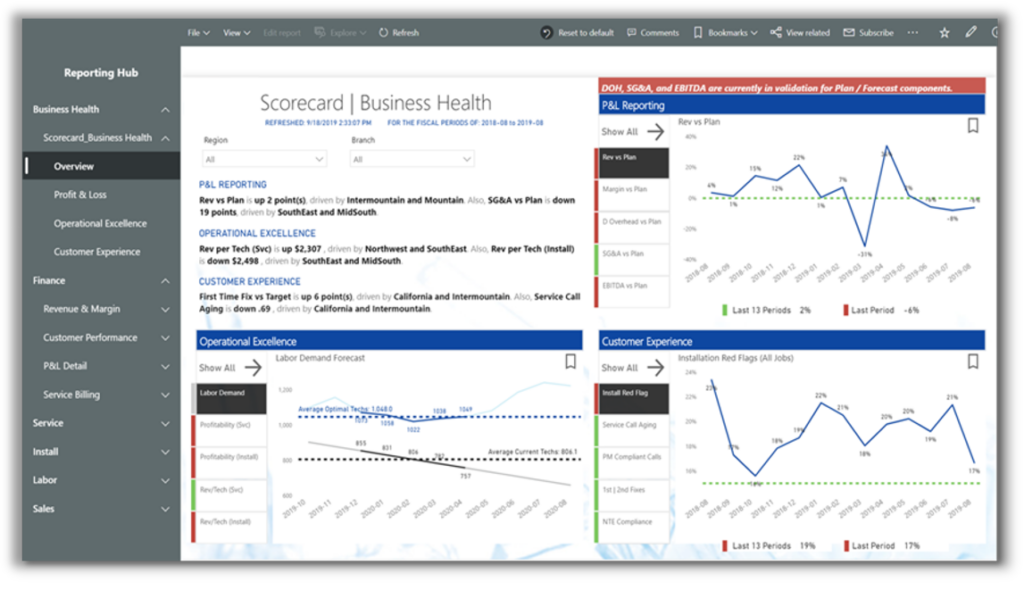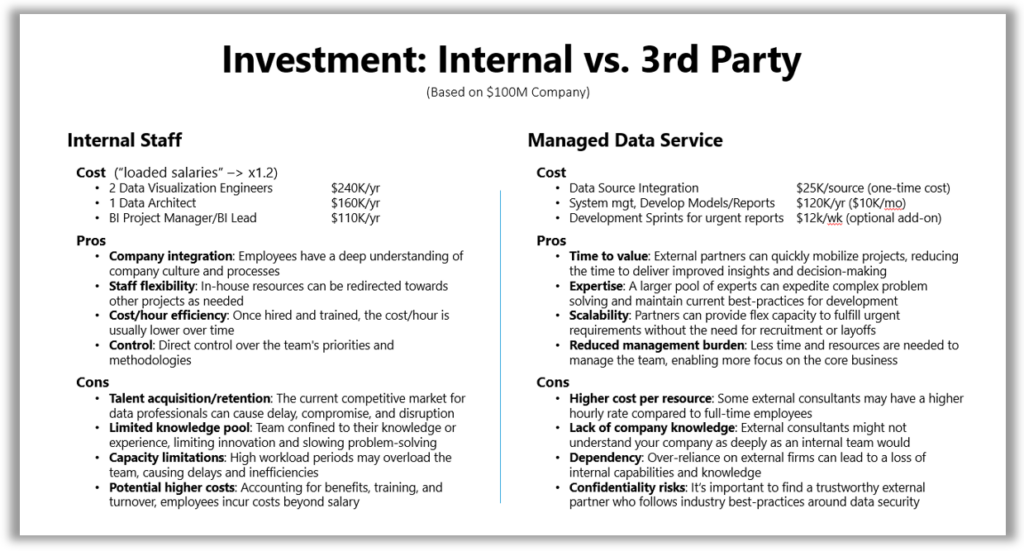In the competitive midmarket landscape, data emerges as a linchpin for gaining competitive advantage. The transformation of data from a byproduct of operations into a valuable asset is at the heart of this evolution. When managed well, data supports decision-making, operational efficiency, and value creation.
Here is how to move your company from data status quo to industry leader.
Current State: Typical Midmarket Data Environments and Challenges
The typical data environment in the midmarket is characterized by disconnected sources of data from various ERPs, CRMs, FP&A tools, spreadsheets, and databases that leave analysts relying on inefficient, manual extraction processes and Excel-based reporting.
Management teams are often left relying on point-in-time snapshots without historical context and trending insights, and it’s not uncommon for there to be conflicting definitions of key metrics between those snapshots which can lead to confusion and misalignment. This can lead to distrust of the reporting, making decision-making more difficult than it needs to be.
In short, decentralized data collection and reporting constrains value creation within midmarket companies.
Do any of the following sound familiar?
- Limited Basis for Decision-Making: Leaders are left spending the bulk of their time wrangling data and reporting instead of making decisions and improving performance.
- Lack of Alignment, Autonomy: When information is lacking, people tend to fill in the narrative with assumptions. When the Board or management team lacks clear visibility into performance, micro-management and division can quickly take hold.
- Retrospective, Point-in-Time Visibility: Dependence on Excel requires exporting data from multiple systems and manually building reports for a limited audience, surfacing issues and opportunities well after the fact.
- Subpar Integration: With each acquisition, new ERPs and CRMs introduce additional disparate data that hinders integration and gaining economies of scale, requiring costly and time-consuming systems-integration efforts to fully realize the value of an investment.
- Operational Inefficiency: Without visibility across the organization, teams struggle to coordinate, resulting in excess meetings, emails, and reports to stay in sync. As teams get out of sync on key initiatives, gaps are overlooked, work gets duplicated, and efforts don’t support each other as well as they could.
- Limited Ability to Leverage Emerging Technology: Without integrated, reliable data, companies run the risk of falling behind the curve on being able to use emerging data and generative AI tools to increase value. A well-organized data environment puts a company in position to immediately take advantage of AI-supported Natural Language Querying as it becomes mainstream in the near future.
Future State: What Good Data Management Looks Like
According to Adam Coffey, three-time PE-backed CEO, who has bought and sold 58 companies, “Companies that are more sophisticated from a data perspective are also more valuable. They trade for higher multiples and sell more quickly.”
But what marks a sophisticated data strategy?
Sophisticated data management goes beyond operational efficiency. It ensures that data becomes an asset that drives value creation, fosters alignment with the value creation plan, and positions the company to maximize valuation at exit.
A comprehensive data management strategy addresses the primary challenges of midmarket executives by:
- Eliminating the need for manual data collection and reporting.
- Providing executive (and Board) insight into company performance on a single screen, with a contextual and trending view of performance over time.
- Giving employees clear visibility to KPIs to drive a culture of informed decision-making and operational efficiency.
- Aligning organizational reporting and metrics to seamlessly roll up to executive dashboards which support accountability and strategic decision-making and prioritization.
- Showcasing true business unit integration by demonstrating exponential value of acquisitions – economies of scale, unified strategy, and multiple expansion.
- Supporting higher valuations and faster exits by demonstrating mastery over the numbers, presenting an empirical value-creation narrative, and minimizing uncertainty.
Here’s a quick snapshot of good data management — an overall Business Health Scorecard and Reporting Hub:

Leading Edge: What Great Data Management Looks Like
While good data management has been a hallmark of industry leaders, in the next 6-12 months, AI analytics and Natural Language Query (NLQ) are poised to disrupt the midmarket, and the companies who have already implemented their data architecture to leverage these advances will gain a competitive advantage. With one clear advantage being increased employee productivity.
McKinsey estimates knowledge workers spend 19% of their time searching for and gathering information, so great data management demands an integrated approach. The modern data platform is characterized by a single, integrated data source (a data lakehouse) that enables self-serve analytics and generative AI reporting capabilities, greatly reducing your workforce’s time spent gathering and reporting on data. The added element of NLQ will soon enable analysts (as well as executives) to simply ask questions of your data sources to surface insights.
Here’s an example of that exact scenario from Microsoft’s demo of Power BI Copilot, a generative AI assistant, to be released toward the end of 2023. In a matter of seconds, Power BI Copilot can turn your question into a dashboard. (Here is a 3-min preview of Power BI Copilot.)

A Midmarket-Sized Approach: A Managed Data Platform
While a modern data platform lays the foundation for a state-of-the-art BI infrastructure, a managed data platform and ongoing monthly monitoring enables the midmarket to right-size their data management. Talent shortages can hinder the ability to stand up an internal data team that can consistently monitor and strategically manage data assets.
A managed data service provides:
- Secure Cloud Storage: Securely hosted data in a cloud-based data lakehouse.
- Cyber Security: Industry standard protocols keep data protected.
- Frequent and Regular Data Updates: Scheduled and managed ingestion of operational data to keep your data lakehouse and related reports up to date.
- Data Health and Safety Measures: Consistent data monitoring to quickly detect and address any issues that might arise.
- Monthly Development Time: Tailored data model creation and report development to support your business decisions.
- Dedicated Executive Support and Expert Data Consultation: Regular advisory meetings for high-level strategic guidance, as well as a team of engineers to manage your solution.
(Read more about the specific offerings of Blue Margin’s Managed Data Service here.)
The Path to Data Maturity
The journey to data maturity happens in phases. It begins with recognizing the value of data and culminates in a state where data drives strategic decisions, fosters growth, and creates tangible value. Along this journey, companies transform their mindset, placing data at the core of their operations and strategic initiatives.
First, to quickly progress from a typical, baseline data environment to mature and strategic data management, Blue Margin recommends that companies start by assessing their data-readiness. This looks like a 60–90-minute workshop to understand where data can be leveraged to advance value creation initiatives. [Schedule your no-cost workshop.]
Next, define a roadmap, a 100-Day Plan, and identify whether to hire internal or external resources to execute. Companies can opt for an internal approach, hiring and building capabilities in-house, or leverage third-party expertise. Each approach has its merits, and the choice hinges on a company’s specific needs, existing capabilities, and long-term vision. For the majority of midmarket companies, the time and expense to stand up and maintain an internal team isn’t the best use of budget (we have an entire podcast on that topic: Not Quite ‘Big Data’: A Middle Market-Sized Approach to Data Management). Blue Margin provides all of the data management and reporting services our clients need for half the cost of a small, internal team of four.
Here’s some of our thinking around the internal or 3rd party investment:

Regardless of the internal/external approach, the next step to data maturity involves consolidating company data into a data lakehouse (a process that takes less than 2 weeks) to provide rapid access to centralized, trustworthy data for analysts, report writers, machine learning, data science, and emerging AI tools.
With data and AI poised to redefine the midmarket landscape, the time to act is now. Leveraging data well demands a strategic approach, underpinned by robust data management practices. Whether you’re at the start of your data journey or looking to optimize existing capabilities, the path forward is clear: strategic data management is not just an option; it’s a necessity.

